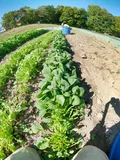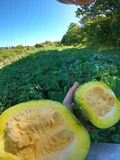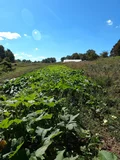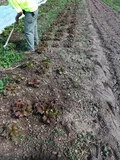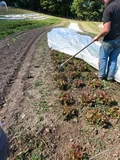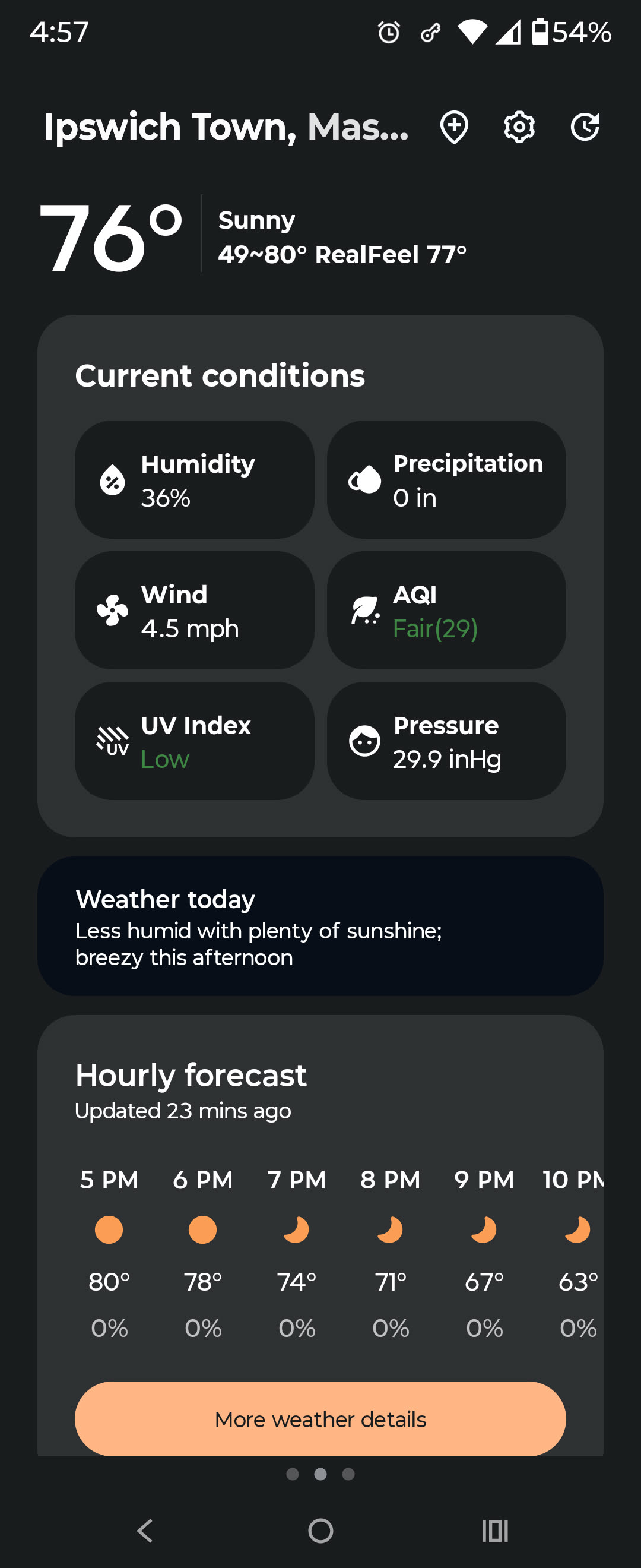TL;DR
I washed bins then harvested tatsoi, basil, tomatoes, and butternut squash. We weeded lettuce with stirrup hoe and started deconstructing tomato trellises as well.
I also spend some head cycles coming up with a way to frame feedback, particularly that between the ecosystem of a farm and observers/operators. Loosely based on signal processing, this is more about the return to the input of a part of the output of a machine, system, or process rather than (‘feedback’ as used commonly in office settings) the transmission of evaluative or corrective information about an action, event, or process to the original or controlling source.
Firstly, the Butternut Squash
On Monday and Tuesday, we went through the delicata and butternut fields to snip the gourds from their vines. Then we let them sit in piles in the fields to age a few days before bringing them in to the garage for dry storage. Even when only half full, a green bin of heavy squash is…very…heavy. I’ve gotten the process of hoisting one onto my right shoulder down so that it doesn’t hurt my back, since carrying them at mid-level seems to do so far more.
We will begin distributing them in CSA member shares and selling them at the farmer’s market next week. I will likely take the two I have and trial a few recipes to bring to the member potluck next month.
Secondly, the tatsoi
I was pleasantly surprised to enjoy the tatsoi this season. Often the choy families are too ‘brocco-leafy’ for me, some also causing a chalky sensation in my mouth due to their levels of oxalic acid (the worst for me is plain spinach). But the tatsoi had only a mild broccoli flavor and a nice, crisp texture. It was also very quick to grow and easy to harvest.
Thirdly, the Tomato Trellises
We started deconstructing the field tomato trellises today, two rows that are completely done. I remember like it was only yesterday (nope, it was May 21st) when we painstakingly pounded all the stakes into that field. I remember planting the leggy tomatoes thinking that they might not make it (they did). I remember asking Jamie about when we should add the second and third weaves on the trellises.
Mostly, I’ll remember sitting in the rows, pushing up the overgrowth with one arm and picking the tomatoes with the other hand, in the deep heat waves of summer.
Finally, Framing Feedback
Okay, so I spent some time thinking about weak and strong signals, particularly what to do (or not do) with them when encountered. For instance, a weak signal that someone is interested (or not) in an idea or issue can easily be missed, but a strong signal definitely should not. Action should not always be taken, but options for how to interpret, reframe, and/or respond to them should be considered…hence a framing.
What’s All This Rubbish about Framing Anyway?
Framings are useful as the backdrop to most structured thought. They are everywhere in business, philosophy, science, and mathematics. They help as canonical references for both top-down and bottom-up thinking. If in the weeds about something, frames can help you get your brain up and out of them to make sure a more holistic view is considered. If to high up in the clouds (abstract) on a project, frames can remind you where there are gaps to fill with detail to make the effort align to reality. Framings are the mental meat grinders to structured though processes.
In many conceptual frameworks though, the real world is simplified down so that the few key concepts underlying the framework become the primary focus. Unfortunately, reintegrating anything abstract learned in this mode back into real-world contexts can sometimes be challenging, particularly if the complexity of the framework doesn’t match the ability of those using it. This is where ‘context markers’ come in to play…unlike abstract concepts and terms, context markers are more real-world examples and words that we can remember and use to help us understand and apply the concepts in practice.
Why Focus on Feedback in Agriculture?
Farmers observe much. Good farmers listen to what their fields, crops, livestock and broader land ecosystem is telling them. Nature uses mostly weak signals until the few strong ones are all that’s left.
Lost crops, infertility, droughts, floods, and wildfires are strong signals…whereas soil erosion, increased pest and disease pressure, poor uptake of nutrients or conversion from crop to produce…are weak signals that somethings not quite right. Imbalances in the ecosystem can lead to weak signals that are not immediately obvious, and lack of compensating action to balance over time can lead to huge losses. Conversely, over-reacting to every little weak signal can also lead to imbalance and even burnout. Looking for weak and strong signals isn’t enough; you need to know what and when to do (or not).
Constructing the Initial Frame
I knew that the ‘weak vs. strong signal’ axis would be a good way to think about one part of this framing, but I also considered many other cross-axes. For today, I ended up deciding on ‘rejection vs. projection’ as a cross-spectrum which seems to harmonize the ideas of potential analysis, refactoring, and action adequately (for a weekday evening’s initial thought work). This way, a variety of ‘what to do with it (or not)’ topics can fit within each quadrant’s detailed example items.
More to Come…Tomorrow’s Update
I need to thing more about agricultural, ecological, and biological examples to put into this frame so that it’s more concrete and actionable. The ‘context markers’ are of course the quadrant labels: strong-amplify, strong-dampen, weak-dampen, weak-amplify.
AI Summary from Field Notes
This weekend, I think I may finally tackle building a RAG prototype for this farm notes site’s automated summarization of field notes. I have plenty of historical transcripts and their point-in-time existing summaries to compare to, so quality validation of a new process won’t be hard. I think it will be how to choose the external sources of information, pick the highest quality ones, and then how to limit the cycles on which the RAG process thinks on the specific topics.
I do think that the current process does a good (enough) job of breaking apart the key concepts and topics into distinct categories, and this is necessary because I can’t expect a RAG process geared towards processing individual topics to work well on a generic transcript of my words. So if I were to guess, the process might go something like:
- Generate transcript; parse out key concepts (theme, new activity, research area)
- For each concept, run it through a RAG which pulls in relevant sources
- Instruct the final prompt to generate one or two questions and suggested actions
- Provide top sources used in the RAG process as references in the final output
- Combine each topic and it’s RAG results into a final, consolidated summary
Yeah, that’s what I think I’ll work on this weekend. Forget the existing trello backlog of homelab maintenance and mobile app development. It can (and will) wait, secretly sulking in the corner, as it always does.
Summary
Consolidated Summary
Main Themes
- Crop Management: Harvesting and maintenance of leafy greens (e.g., tatsoi) and gourds.
- Field Maintenance: Managing agricultural stakes (e.g., Florida weave stakes) and plastic waste.
- Storage & Logistics: Designing and optimizing storage solutions for squash.
- Animal Care: Feeding and managing the gator.
- Equipment & Safety: Proper use of agricultural tools and waste management.
Key Activities
- Harvested leafy greens (tatsoi) and gourds.
- Maintained agricultural stakes (Florida weave stakes) and managed plastic string waste.
- Constructed and monitored a custom storage vessel for squash.
- Collaborated with volunteers for gourd harvesting.
- Fed the gator and loaded feed.
New Experiences
- tatsoi: A specific leafy green (likely Rorippa or Brassica species).
- Florida Weave Stakes: Trellising tools used in fields.
- Storage Vessel: A wooden crate lined with cardboard for squash preservation.
- Plastic String Management: Systematic collection and disposal of field waste.
- Volunteer Collaboration: Working with educational volunteers for field tasks.
Key Questions
- How to minimize plastic waste and its environmental impact?
- What are best practices for safely removing stakes?
- How to improve the storage vessel for long-term squash preservation?
- Does repeated stake use affect plant growth?
- How to optimize harvesting techniques for tatsoi and gourds?
Suggested Actions
- Standardize plastic waste collection protocols.
- Document stake removal steps for consistency.
- Regularly inspect the storage vessel for moisture or pests.
- Train volunteers on field tasks and safety.
- Test the storage vessel’s effectiveness for squash preservation.
Part 1
Main Themes
- Crop Management: Harvesting, weeding, and monitoring crops (tatsoi, butternut squash, pumpkins).
- Field Maintenance: Removing plastic string, managing stakes, and ensuring field cleanliness.
- Storage and Logistics: Preparing storage for squash, organizing bins, and coordinating with CSA members.
- Animal Care: Ensuring water and feed for pigs, chickens, and the gator.
- Equipment and Safety: Proper handling of tools (scissors, stakes) and avoiding damage to machinery.
Activities Performed by the Intern
- Washing and Organizing Bins: Cleaned and sorted bins for storage.
- Harvesting: Collected butternut squash from two locations.
- Field Inspection: Checked pumpkin and squash fields for health, damage, weeds, and soil moisture.
- Weeding and Hoeing: Removed weeds and maintained beds.
- Stake Removal: Removed Florida weave stakes from rows, ensuring proper string management.
- Plastic String Management: Collected and bundled plastic string from stakes, trellising, and hay bales.
- Gourd Picking: Assisted in harvesting gourds with volunteers.
- Storage Preparation: Constructed and prepared a storage vessel for squash.
- Animal Care: Watered pigs and chickens, loaded feed for the gator.
New Things Not Yet Encountered
- tatsoi: A specific type of leafy green (likely Rorippa or Brassica species) not commonly known.
- Florida Weave Stakes: A specific type of agricultural stake used for trellising.
- Storage Vessel Design: A custom wooden crate lined with cardboard for squash storage.
- Plastic String Management: A detailed process for collecting and disposing of plastic waste in fields.
- Volunteer Assistance: Collaborating with educational volunteers for gourd harvesting.
Questions and Future Research Areas
- Sustainability of Plastic String: How to minimize plastic waste in fields and its environmental impact.
- Efficiency of Stake Removal: Best practices for removing stakes without damaging the soil or machinery.
- Storage Vessel Optimization: How to improve the storage vessel for long-term squash preservation.
- Impact of Stakes on Crop Health: Whether repeated use of stakes affects plant growth over seasons.
- Harvesting Techniques: How to optimize the harvesting of tatsoi and gourds for yield and quality.
Suggested Actions
- Standardize Plastic Waste Management: Develop a checklist for collecting and disposing of plastic string.
- Document Stake Removal Process: Record steps for removing stakes to ensure consistency and safety.
- Monitor Storage Vessel: Regularly inspect the storage vessel for moisture or pests.
- Train Volunteers: Provide guidelines for volunteers on harvesting and field maintenance.
- Test Storage Conditions: Evaluate the storage vessel’s effectiveness for squash preservation.
[end of post]
Enjoy Reading This Article?
Here are some more articles you might like to read next:

